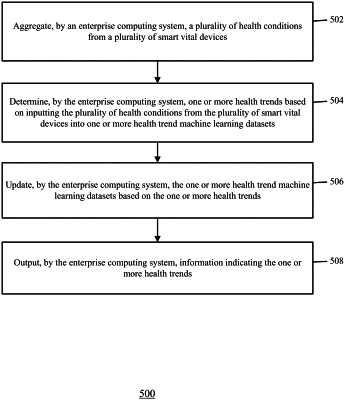| CPC G16H 50/20 (2018.01) [G06N 5/04 (2013.01); G06N 20/00 (2019.01); G16H 50/30 (2018.01)] | 20 Claims |

|
1. A system, comprising:
a first smart vital device, comprising:
one or more first processors; and
memory, wherein the memory stores one or more health condition machine learning models, and wherein the one or more first processors are configured to:
obtain sensor information indicating one or more health characteristics associated with an individual;
retrieve the one or more health condition machine learning models from the memory of the first smart vital device;
input the sensor information into the one or more health condition machine learning models to determine one or more health conditions of the individual;
output one or more notifications indicating the one or more health conditions of the individual; and
provide, to an enterprise computing system, the one or more health conditions of the individual; and
the enterprise computing system, wherein the enterprise computing system is configured to:
aggregate a plurality of health conditions from a plurality of smart vital devices, wherein the plurality of smart vital devices comprises the first smart vital device;
determine one or more health trends based on inputting the plurality of health conditions from the plurality of smart vital devices into one or more health trend machine learning models, wherein the one or more health trends indicate an expected time frame for an expected peak of an affliction;
receive actual information indicating an actual time frame for an actual peak of the affliction;
update the one or more health trend machine learning models based on the expected time frame and the actual time frame; and
output information indicating the one or more health trends.
|